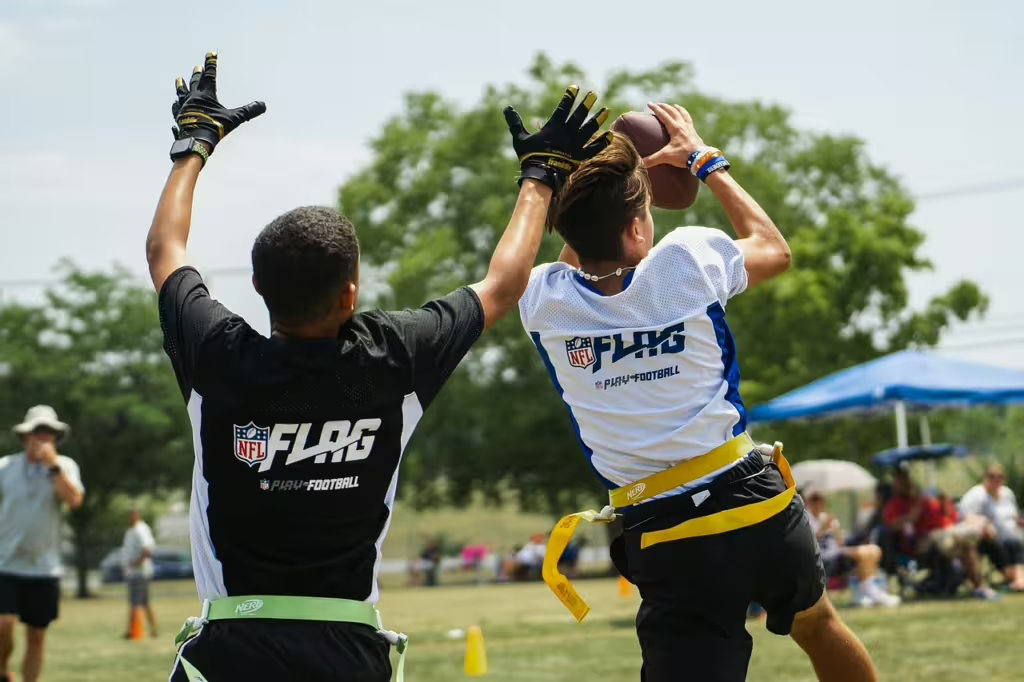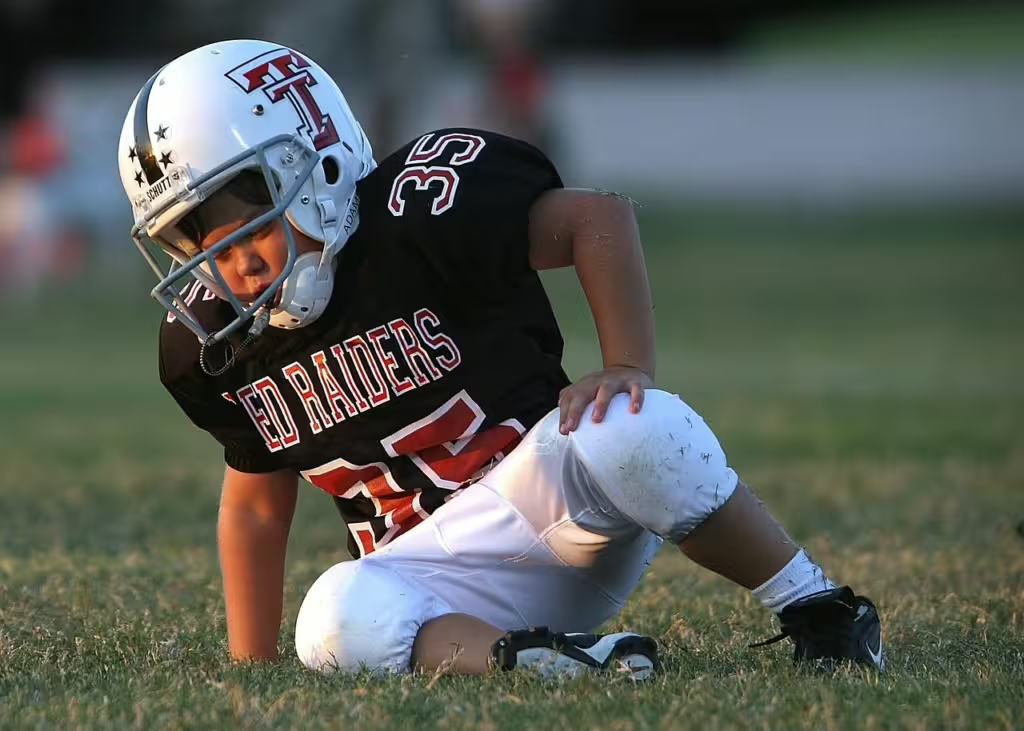It’s autumn and for many families across the United States, football season has officially begun! Americans love their football and the fall season has become almost synonymous with the sport. For many communities, the high school football team is the center of their world. The ensuing games of the season help bring people together as they sit and cheer their team on under the stadium lights. We’ll be honest, the exhilaration of the dynamic game, the sound of the marching band playing, and the roar of the fervent crowd creates an atmosphere that’s hard to find anywhere else.
The thing is, Friday night lights and Sunday football might be the big draws for many, but American love of football often starts much closer to home; and from a much younger age. For many children, their first football experience begins in the backyard, where it evolves into flag football, youth football, and beyond! Many parents might be wondering if football is the right fit for their child, especially if they themselves don’t have a long history or interest in the sport. That is why we are here, to help the uninitiated to understand why football is such an excellent option.
In this article, we will guide parents through the rules, the costs, and any safety concerns that you might have about this All-American sport. In addition to covering the basics, we will also map out which pathways kids and parents might take to bring them to higher levels of play.

Understanding the Basics of Football
The Objective of the Game
This might seem somewhat elementary for some, but bear with us here. The sad fact is that not every American knows the rules of football. Heck, those outside of United States use the name for a very different type of game; namely, the sport we know as soccer. Thus, our need to go over the basics to get everyone on the right page.
American football is played between two teams. The goal is to try to move the oblong ball down the field in such a way that one team scores points by crossing into the opposing team’s end zone; this is known as a touchdown. The other way you can get the football into the opponents end zone is by kicking the ball through the goalposts; this is known as a field goal or extra point. More often than not, the latter is how points are accrued. Football games are divided into four quarters, with teams alternating possessions and players occupying specific positions on the field.
Speaking of positions, that is just one element that parents and beginners should know about to begin with. For instance, players take on familiar-sounding roles like quarterback, running back, wide receiver, lineman, or defensive back. It should be noted that younger leagues often rotate kids through different spots, rather committing one child to one role the whole season long. This is because, like youth sports in general, it is good for children to try out multiple roles to see where they fit the best.
Points are scored as follows:
- Touchdowns (6 points)
- Feld goals (3 points)
- Extra points (1 or 2)
- Safeties (2 points)
Versions for Young Players
For those parents that are worried about their child getting absolutely squashed by a kid twice their size, you needn’t concern yourself right away. Tackle football, that is to say the one that we are all used to seeing on TV, doesn’t usually begin until children are over 10 years of age at least. Instead, most younger kids tend to play flag or touch football. These safer versions involve children wearing flags on their belts which act as a means of “tackling” an opposing player without actually having to bring them to the ground. This version is, as one might expect, much safer for small children.
Moreover, these less strenuous versions allow the players to learn the basics, rules, and strategy of the game without any of the more extreme physical demands. Touch or tag football works in much the same way, though it is commonly played in casual circles and doesn’t really have a whole lot of league support.
Skills Young Kids Need to Learn
Kids who learn to play football will end up building up a number of rudimentary skills that will become invaluable to them in many areas of their lives.
Basic Motor Skills
Football emphasizes the most basic motor skills a child needs to not only play sports, but do most anything they need to physically do. These include: coordination, agility, and balance, but also running, catching, and throwing. All of these represent the foundations of play and as a result, the majority of youth programs focus on developing these motor skills in fun, non-competitive, non-contact settings.
Teamwork and Communication
Unlike certain individual sports, football’s team-oriented play style makes it a great way for kids to learn the value of communication, coordination, and team roles. Remember, every player on the team has a role top play and must execute that role in order for plays to succeed.
Mental Preparation
Football is played as much in the mind as it is in the physical realm. This is a sport that, despite appearances, requires focus, quick decision-making, and resilience. In that way, football helps prepare children mentally for other challenges that may one day come up in their lives.
Parental Concerns: Safety First
Concussions and Head Injuries
Is it safe? This is one of the premier questions parents ask when it comes to football. And one of the biggest concerns parents have about football injuries pertains to concussions. After all, modern research has drawn attention to the long-term impact of repeated head injuries, and the evidence can be seen in the behavior of many former pro-football players. That said, these concerns have been serious enough for football organizers the world over to address them via certain restrictions and practices.
First, many youth leagues delay full-contact play until a child reaches an age of 12 or older. Also, coaches are expected to undergo certification and safety training. And finally, popular programs like USA Football’s Heads Up Football, emphasizes factors like proper posture, tackling, and equipment fitting as it pertains to the youth versions of the sports. Parents can help monitor their child’s safety by first ensuring helmets fit properly and then keeping an eye out for any symptoms of concussion, such as dizziness, confusion, or headaches.
Physical Demands
We’ve said it before and we will say it again, football is an incredibly physically demanding sport; even for the most athletic of children. For this reason, parents should ensure their child is physically ready for practice and for the eventual “big game.” In most cases, getting a preseason physical from a pediatrician is a must for entering a child into the game. There is also some mental pressure that comes with playing on a team and trying for victory. Just don’t overemphasize winning and your child should be able to enjoy their time as they get used to the lay of the land.

Costs of Youth Football
Registration and League Fees
There is a cost to youth football and it isn’t always cheap. It does vary, however. For instance, some local youth leagues will charge registration fees of about $75, while others could be as high as $300; and all numbers in between. This range depends on a number of factors, but it is usually based on location and program size. Such fees are used to cover field rentals, referees, and basic equipment.
Equipment Costs
Once your child makes it to tackle football, equipment costs are going to add up. The breakdown of those costs can be found below, but bear in mind they are only averages; some may be more or less.
- Helmet: $100–$300
- Shoulder pads: $75–$200
- Cleats: $40–$120
- Mouthguards, practice pants, and jerseys: $20–$50 each
Note that many leagues provide loaner equipment or rental programs which can ease the financial burden on some families. Flag football is also far less less costly, which makes it an even more ideal testing ground.
Travel and Time
As with all team sports, parents should factor in the time commitment of practices and games into the cost of playing. Additionally, travel to tournaments or away games can also add expense. Just keep it all in perspective before you introduce your child to this amazingly fun sport.
Introducing Kids to Football: Practical Steps
One of the easiest way to get your child into football is to play with them in the backyard or in a local park. Simply tossing the ball around in a game of catch or playing touch football with friends could help them develop an early love and knowledge of the sport. After that, try out flag football, by joining a local league or school enrichment program. You don’t really want to get them into tackle football until middle school which is when most schools offer the sport anyway.
Encouraging a Love for the Game
As with any sport, the best gift that a parent can give their child is the ability to enjoy the journey. By this, we mean that parents can encourage a love of the sport. Parents should endeavor to celebrate their child’s efforts no matter the outcomes. They should focus on the stages where a child improves, not bring up where they are starting to fall behind. Most importantly of all, they should encourage fun over win. Lean into the community that comes with league play and help your child to make friends with their teammates. You never know when a youth sports friendship will turn into a lifelong one; the same goes with the child’s relationship to the sport itself.

Cultured Athlete Says…
As you can see, fall is the perfect time to begin introducing your children to American football. But this new American pastime is about so much more than touchdowns and trophies, it’s about nurturing a child’ physical skills and enabling them to have fun while doing exercise. Like all team sports, it’s also about teaching the basic tenets of teamwork, socialization, and hierarchy. In that way, football can help both instill discipline in rambunctious young souls, and build their confidence at the same time.
As long as parents are mindful of the cost, time, and safety practices, they can help their child to begin a football career that could very well last them their entire lives. The truck lies in a thoughtful approach—starting with flag football, prioritizing safety, and keeping fun at the center. Doing this will ensure that football is a rewarding part of your child’s growth, not a burden for you or them to have to bear.
Discover more from CulturedAthlete
Subscribe to get the latest posts sent to your email.






